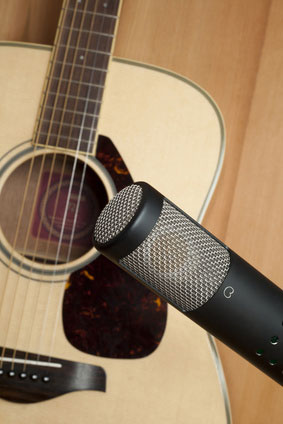 In the following post, there is a video where Graham tests the results of three different microphones ranging in price from just under $100 to $1,000. The mics used were:
In the following post, there is a video where Graham tests the results of three different microphones ranging in price from just under $100 to $1,000. The mics used were:
AKG C414 ($999)
Shure KSM 141 ($399)
Shure SM57 ($96)
The tests they did were to record the same guitar and player, playing the same finger-picked music. The mics were all positioned the same and Graham gain-matched the recordings to make sure volume differences were not a factor in judging one against the other.
You might also want to read the comments below the post for some interesting insight from others. The point of this was not only to show how different the results of different mics can be, even when recording the exact same thing (useful in itself to perhaps add dimension and variety to your mixes), but also to highlight the fact that you can get useable and even really good results from a mic costing ten times less than another (I guess it’s more correct to say costing 1/10th the price – whatevs:)).
Anyway, check out this video if you do music recording. Very interesting.
I’m going to keep using my Shure SM81 to record acoustic guitar though. I’m hooked;).
http://therecordingrevolution.com/2012/08/15/acoustic-guitar-microphone-shootout-video/
Cheers,
Ken
microphones
Matching A Microphone To A Preamp
 In 2012 the likelihood that a decent recording microphone will be horribly mismatched with a decent mic preamp (included in the audio interface units I talk about on this site) is, in my opinion, really low. Now, when I say “decent,” I’m talking about microphones from well-known and respected manufacturers like Shure, Audio-Technica, Rode, Neumann, AKG, Blue, Mojave Audio, etc. Preamps (see our article – What is a Mic Preamp?) these days are almost always integrated with the audio interface, and in the case of a USB mic, integrated directly into the mic (so need for worrying about mismatches). When I say “decent” in the context of audio interfaces, again you’re unlikely to go wrong with units by companies like M-Audio/Avid, EMU, CEntrance, ART, PreSonus, Focusrite, Behringer, etc. Obviously there are more, especially in the very high-end market. But my point is this – if you have an Audio-Technica AT2035 microphone (see our review here: Review of the Audio-Technica AT2035 Microphone), you don’t need to worry whether plugging it into an M-Audio Fast Track C-600 interface. It’ll sound great!
In 2012 the likelihood that a decent recording microphone will be horribly mismatched with a decent mic preamp (included in the audio interface units I talk about on this site) is, in my opinion, really low. Now, when I say “decent,” I’m talking about microphones from well-known and respected manufacturers like Shure, Audio-Technica, Rode, Neumann, AKG, Blue, Mojave Audio, etc. Preamps (see our article – What is a Mic Preamp?) these days are almost always integrated with the audio interface, and in the case of a USB mic, integrated directly into the mic (so need for worrying about mismatches). When I say “decent” in the context of audio interfaces, again you’re unlikely to go wrong with units by companies like M-Audio/Avid, EMU, CEntrance, ART, PreSonus, Focusrite, Behringer, etc. Obviously there are more, especially in the very high-end market. But my point is this – if you have an Audio-Technica AT2035 microphone (see our review here: Review of the Audio-Technica AT2035 Microphone), you don’t need to worry whether plugging it into an M-Audio Fast Track C-600 interface. It’ll sound great!
However, I’m a fan of the old saw – knowledge is never wasted. And there are still times, especially when working with very high-end equipment looking for the pinnacle of conceivable performance specs, when it could be handy to understand how the electronics interact with one another to degrade or enhance the resulting sound. In that vein, I refer you to this article explaining the terms and numbers involved in mic and preamp specs:
http://www.prosoundweb.com/article/selecting_the_right_preamp_for_your_microphone/
The New Sennheiser MKE 600 Shotgun Mic Now Available
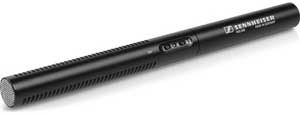
This is really exciting. Sennheiser announced their new shotgun mic, the Sennheiser MKE 600, very recently and you can be among the first to get one. It’s available at B&H, the first retailer to stock and ship the new mic. You can order yours by clicking here.
The reason I said it was so exciting was that I have stated that my “desert island mic” was the Sennheiser MKH 416 shotgun mic (see my review, along with audio and video samples here: https://www.homebrewaudio.com/sennheiser-mkh-416-shotgun-microphone-review/). But that one costs about a thousand clams. If the new MKE 600 sounds anywhere near as good as the MKH 416, it will be a fantastic value at just $399.95. Plus I can justify that to my wife a lot easier than the grand I’d have to drop for the 416;).
One feature of the MKE 600 that I like a lot is that it can use phantom power or a battery. That is VERY significant and convenient for a mic designed to be primarily used for video because most video cameras don’t have phantom power available on them for microphones. Heck, just finding a video recorder with an external mic hookup is hard enough. When I recorded the videos for the review of the 416, I had to use a separate phantom power unit plugged into a wall to power the mic. The MKE 600 also has a low-battery indicator so your audio won’t suddenly cut out on you in the middle of a shoot.
Again, you can find out more and order yours by clicking here.
Cheers!
Two New Studio Quality iPad Microphones
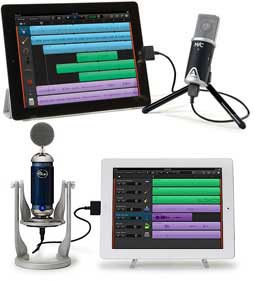 Lately there have been a lot of audio devices for iOS – meaning for iPad, iPhone and iPod Touch. So far it has been difficult to get really great audio recording using an iOS microphone (like the IK Multimedia iRig Mic – see our review of that here –
Lately there have been a lot of audio devices for iOS – meaning for iPad, iPhone and iPod Touch. So far it has been difficult to get really great audio recording using an iOS microphone (like the IK Multimedia iRig Mic – see our review of that here –
Review of IK Multimedia’s iRig Microphone For iPhone, iPad, and iPod Touch) or iOS mic interface/preamp (such as the IK Multimedia iRig PRE). both of which attach to the iPad via the mic/headphone jack. But even though the quality of those is pretty good, the interface via the mic/headphone jack limits the audio quality.
Enter two notable microphones for iOS, the Blue Spark Digital, and the Apogee Electronics MiC. Both of these microphones use the Apple 30-pin connector as opposed to the mic/headphone jack, and both double as USB mics that you can use with both Mac and/or PC (the Blue works with both but the Apogee only mentions working with Mac). And of course, the names Blue and Apogee Electronics are well-respected manufacturers of excellent quality audio gear. I read an article yesterday that proclaimed the Blue Spark Digital to be the “first studio grade condenser mic available for iPad.” While it may have been first, it is no longer the “only” mic in that category with the availability of the Apogee MiC.
Blue Spark Digital
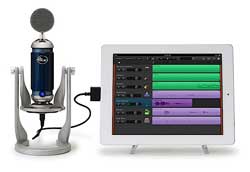
The Blue Spark Digital microphone is a USB/iOS version of Blue’s solid state Spark cardioid condenser mic, sharing all the top-notch components. It also has a headphone jack on the mic. In addition, it has a feature called the Focus control, a button that offers two sonic modes. Normal mode is for increased low frequency sensitivity, and Focus mode is for “even greater clarity and detail.” It’s perfect for recording vocals and acoustic instruments. It comes with a desk stand with integrated shock mount, a Y-cable with USB, iPad and headphone connectors, and Blue’s Cloud Production bundle for audio back-up and sharing on-line. $199.99
Apogee Electronics MiC
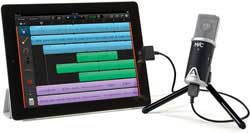
The Apogee MiC, is also designed primarily for vocals and acoustic instruments and, like the Blue, also has a cardioid pickup pattern. Also as with the Blue, the Apogee has a control knob for input level adjustment as well as a meter to monitor input signal levels. It comes with a tripod desk stand, an iOS connection cable and a Mac connection cable.
Both mics sound fantastic and as far as I know, the highest quality mics available for recording on an iPad, iPhone, or iPod touch. And don’t forget that both can also be used with a computer via USB (though the Apogee can only be used with a Mac). $199.
Advice On Best Home Recording Studio Mic For Rapping
 Over at Yahoo! Answers, someone just asked for advice on a microphone in the price range of 200-500 that he could use for recording rap on his home recording studio. Here’s his question:
Over at Yahoo! Answers, someone just asked for advice on a microphone in the price range of 200-500 that he could use for recording rap on his home recording studio. Here’s his question:
Q: What is the best type of microphone for home recording?
I’m making a home studio for rapping and need a good microphone, possibly 200-500 dollars. I want a good one so if I have to pay a little more I’ll do it instead of paying a little for something that sucks. Please help.
And here is how I answered his question:
A: You’re going to want a large diaphragm condenser type of mic. My absolute favorite (in that price range anyway;)) is the Rode NT2-A, which runs about $399. I record all my vocals, both singing and voice-over stuff, with it. Another solid choice for less money is the Audio-Technica AT2035 for about $149. Keep in mind that these mics both need an audio interface with phantom power like the M-Audio Fast-Track (not sure if you already had that covered). Anyway, if you’d like to hear how both of these mics sound, I did a review of the AT2035 and tested it against the Rode, and put the audio results on the page here: Review of the Audio-Technica AT2035 Microphone. I hope that helps!
This question gets asked pretty frequently with the only variable usually being the price range. Interestingly, I’ve never seen anyone give a price range of $800-$1,500 or higher;). But as soon as they do, I’ll post it here on the site.
Cheers!